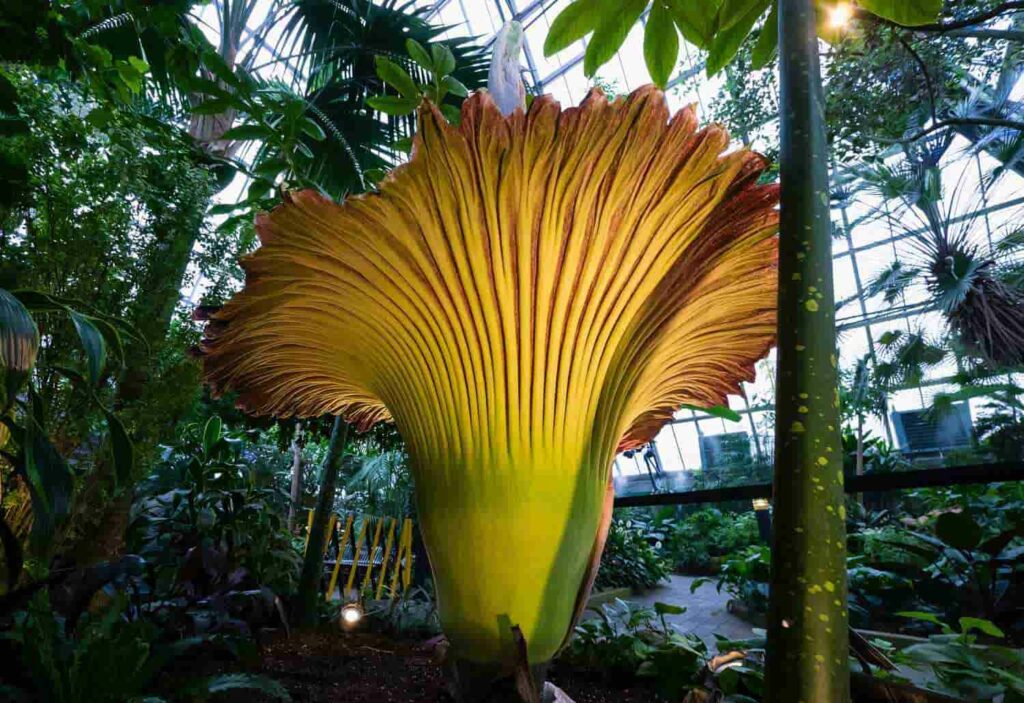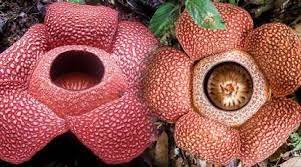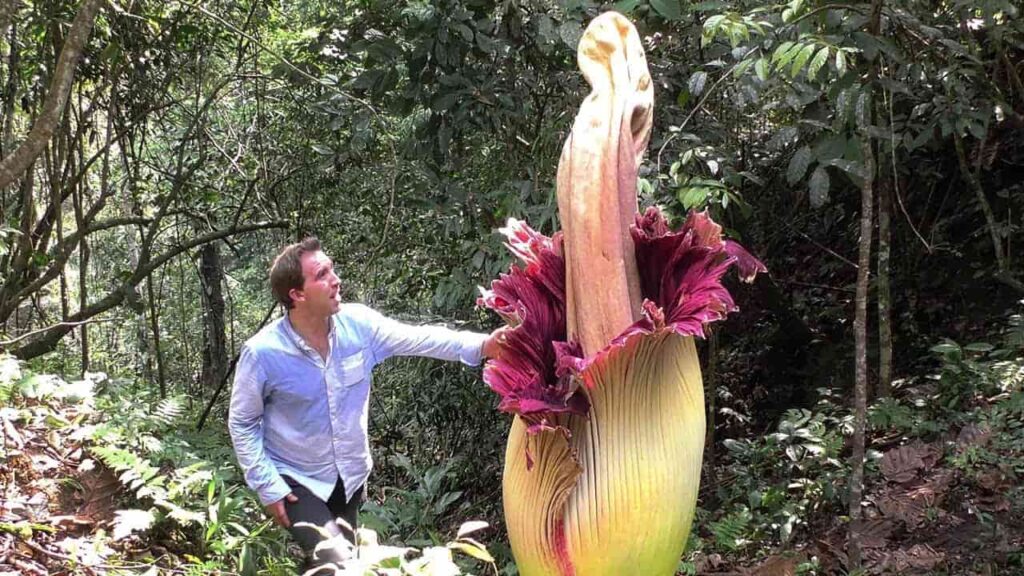Biggest Flower In The World – Unlock The Information!

Encountering the world’s largest flower, the Rafflesia arnoldii, was unforgettable. Its immense size and unique scent left me in awe of nature’s wonders, deepening my appreciation for the rainforest’s beauty.
The biggest flower in the world is the Rafflesia arnoldii, known for its enormous size, reaching up to 3 feet in diameter, and distinctive foul odor, resembling the scent of rotting flesh. It’s found in the rainforests of Sumatra and Borneo.
Uncover nature’s marvels hidden within the rainforests of Sumatra and Borneo in this captivating exploration!”
What is the Biggest Flower in the World? – Explore For All Details!
Rafflesia arnoldii is the name of the biggest flower in the world. It’s not like the flowers you might see in a garden; it’s much bigger and looks very different. Instead of being colorful and pretty, it’s usually red with white spots and has a very strange smell.
1. Why it’s known as the biggest flower:
- It’s called the biggest flower because it grows much larger than any other flower we know.
- In fact, it can grow up to 3 feet (about 1 meter) in diameter, which is about the size of a hula hoop!
- Its size is what makes it so unique and interesting to people who study plants and flowers.
2. Quick facts about its size and appearance:
- The Rafflesia arnoldii is found in the rainforests of Sumatra and Borneo, which are places with lots of trees and plants.
- When you see it, you might think it’s a fungus or a strange plant because it doesn’t look like a typical flower.
- But despite its odd appearance, it’s still a flower, just a very big and different one compared to what we usually see.
3. Historical Background of Rafflesia arnoldii’s Discovery:
- Rafflesia arnoldii was first discovered in the early 19th century by two explorers named Sir Stamford Raffles and Joseph Arnold.
- They were exploring the rainforests of Sumatra, which is an island in Indonesia known for its diverse plant and animal life.
- During their explorations, they stumbled upon this extraordinary flower, which was unlike anything they had ever seen before.
How Big is the Biggest Flower? – Unveil Nature’s Magnificence Today!

1. Detailed measurements and comparisons:
- The biggest flower in the world, Rafflesia arnoldii, can grow really, really big.
- It can be as wide as 3 feet, which is about the same size as a large hula hoop!
- Imagine a flower that’s so huge, it can cover a big part of the ground where it grows.
2. Visual representations for better understanding:
- Picture a flower that’s bigger than your head, bigger than a dinner table, or even bigger than a bathtub!
- To understand just how enormous it is, imagine trying to hold it in your arms or carry it around – it’s so big, you’d need a lot of help!
- Seeing pictures or drawings of Rafflesia arnoldii can help you imagine just how massive and impressive it truly is.
Why Does it Smell Bad? – Access More Right Away!
1. Explanation of the foul odour:
The biggest flower in the world, Rafflesia arnoldii, has a very strong and unpleasant smell. This smell is often described as being like rotting flesh or a dead animal.
It’s not a pleasant smell for us, but it serves a specific purpose for the flower.
2. Purpose of the odor for the flower:
The foul odor of Rafflesia arnoldii attracts insects like flies and beetles. These insects are drawn to the smell because they think it might lead them to food, like decaying flesh.
When the insects come to investigate the smell, they end up landing on the flower and inadvertently help with pollination.
In other words, the bad smell acts like a signal to insects, inviting them to visit the flower and help it reproduce.
How Does it Reproduce? – You Should Know!

- Reproduction Process: Rafflesia arnoldii reproduces in a fascinating way. It starts with a tiny seed that needs a specific environment to grow. Once the seed finds the right spot, it develops into a small plant, but it doesn’t look like a flower yet.
- Becoming a Flower: Eventually, this plant develops into a flower bud, which takes several months to mature. As it grows, the bud gets bigger and bigger until it finally opens up into the massive flower that we see.
- Attracting Pollinators: The flower emits a strong, foul odor that attracts insects like flies and beetles. These insects visit the flower looking for food, thinking the smell comes from something dead.
- Pollination: When the insects land on the flower, they accidentally carry pollen from one flower to another. This transfer of pollen from one flower to another is called pollination, and it’s essential for the flower to produce seeds and reproduce.
- Formation of Seeds: After successful pollination, the flower develops into a fruit-like structure that contains seeds. These seeds can then fall to the ground and grow into new Rafflesia plants, starting the cycle all over again.
In summary, Rafflesia arnoldii reproduces by attracting pollinators with its foul odor, which helps in transferring pollen between flowers, leading to the formation of seeds and eventually new plants.
Is it Endangered? – Learn More In Just One Click!
Rafflesia arnoldii, the biggest flower in the world, faces threats to its existence, making it a concern for conservationists.
One major threat is habitat loss due to deforestation, as the rainforests of Sumatra and Borneo, where it’s found, are being cleared for agriculture and development.
Additionally, illegal harvesting and over-tourism can disrupt its fragile ecosystem. Efforts to conserve Rafflesia arnoldii include establishing protected areas and implementing regulations to limit human impact.
Conservation organizations work to raise awareness about the importance of preserving its habitat and reducing threats.
Research on its biology and ecology helps inform conservation strategies, aiming to ensure the survival of this remarkable species for future generations to appreciate and study.
Where Can You See Biggest Flower in the World ? – Discover More Now!

1. Native Habitat:
Rafflesia arnoldii is primarily found in the rainforests of Sumatra and Borneo. These regions are located in Southeast Asia and are known for their rich biodiversity.
2. Specific Locations:
Within Sumatra, Rafflesia arnoldii can be spotted in places like Gunung Leuser National Park and Bukit Barisan Selatan National Park. In Borneo, it’s found in areas such as Gunung Palung National Park and Lambir Hills National Park.
3. Guided Tours and Trails:
Visitors can join guided tours or hikes organized by local tour operators or national park authorities. These tours often take visitors to known Rafflesia spotting locations within the rainforests.
4. Local Knowledge:
Local guides and indigenous communities living near the rainforests may have knowledge of specific areas where Rafflesia arnoldii blooms. Seeking guidance from these locals can enhance the chances of spotting the flower.
FAQs:
1. What is the lifecycle of the biggest flower in the world, Rafflesia arnoldii, from seed to mature flower?
The lifecycle of Rafflesia arnoldii begins with a tiny seed, which grows into a small plant before developing into a flower bud. Over several months, the bud matures into the massive flower we recognize, completing its lifecycle.
2. What role does the biggest flower in the world, Rafflesia arnoldii, play in its ecosystem?
Rafflesia arnoldii plays a crucial role in its ecosystem by attracting pollinators, contributing to nutrient cycling, and serving as an indicator of the rainforest’s health and biodiversity.
3. How long does it take for the biggest flower in the world, Rafflesia arnoldii, to bloom?
The Rafflesia arnoldii, the biggest flower in the world, typically takes around 9 to 10 months to bloom from the initial bud stage until it reaches full maturity.
4. How do scientists study and research the biggest flower in the world, Rafflesia arnoldii?
Scientists study and research Rafflesia arnoldii through field observations, genetic analysis, and monitoring of its habitat to understand its lifecycle, ecological interactions, and conservation needs.
Conclusion:
The Rafflesia arnoldii, the biggest flower globally, represents a remarkable wonder of nature. Its immense size and ecological significance underscore the importance of conservation efforts in preserving its habitat and biodiversity.
Read:




